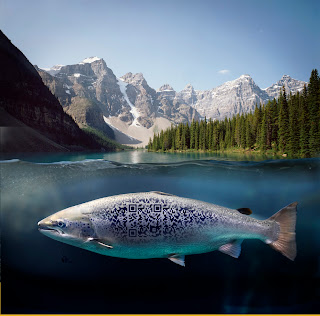For some, the craze of QR codes has come and gone without much flash. For others it is just beginning. The standard black and white QR as shown below does very little in the way of differentiating between brand identities. Is it for Coke? Pepsi? United Airlines? Who knows? Does it elicit any feeling? I didn't think so...
That is where something like Designer QR codes come into play. In-turn many see this as a key driver in the re-birth of this technology.
A Designer QR code (quick response code) is a clever and imaginative way of taking a standard black and white code and transforming it into something which speaks and communicates about your brand and what it stands for. In essence they really captivate people's imagination in new and intuitive ways and allow for the connection between the physical world to that of online. They also allow for tracking of information such as geographical location, time and other key metrics useful to advertisers.
Another relevant point for this debate on the re-birth of QR, is noting the cycle we all seem to find ourselves within as relating to new technological innovation. It is well documented that as new waves of opportunity and capability are bestowed upon us, too often we as users and marketers are caught up in the romance of the technology itself and what it can do. However often times we do not pay enough attention to the actual applications which are best suited to the technology itself. This problem had certainly affected QR in an early adopter country like Japan initially via errant codes being placed in questionable locations which surely did not allow for the best use of its capabilities.
Where things get interesting, is that it seems as though marketers are catching up and finally understanding practical applications for the media. Enter in other developed markets such as the North America and some other European countries which finally have phones and infrastructure which are able to handle the technology. Now you have a potentially interesting mix of relevant experiences to draw upon from early adopter markets (both a TO DO and NOT TO DO list when it comes to application).
In returning to the newness of the Designer QR code capability, we have a technology that could really make some serious headway in connecting both our offline and online worlds in fun and engaging ways.
Here some 2011 Q3 global stats for QR code use, from research firm 3GVision via 2D Code blog editor, Roger Smolski:
- Worldwide usage on growth path: Q3/2011 growing by 20.0% over Q2/2011, with daily scans coming from 141 different countries around the world
- Barcode usage in North America continues to expand in Q3 with 42.1% growth in the USA and 35.1% growth in Canada compared to Q2/2011
- QR code activity in the Spain and Australia showed a significant growth in Q3 of 66.5%, and 50.9% respectively over Q2/2011
Top 10 users of mobile barcodes during Q3/2011
(1) 1. United States
(2) 2. Germany
(5) 3. Canada
(3) 4. UK
(4) 5. Italy
(2) 2. Germany
(5) 3. Canada
(3) 4. UK
(4) 5. Italy
Top 5 growing countries for Q3/2011
1. Czech Republic (66.5 % Growth over Q2/2011)
2. Spain (65.6 %)
3. Australia (50.9 %)
4. USA (42.1%)
5. Canada (35.1%)
2. Spain (65.6 %)
3. Australia (50.9 %)
4. USA (42.1%)
5. Canada (35.1%)
If you would like more information on Designer QR codes please contact us at BRANDPOINT Advertising. http://www.brandpoint.jp/en
Check out the examples below of other fun ways to use the Designer QR Code:









